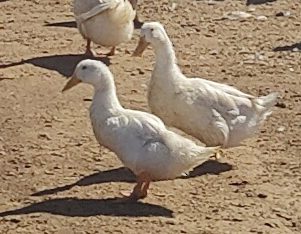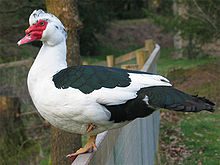- Daily: 9am - 5pm
- 714-757-2976

The Crested Duck breed is a unique medium-sized, dual-purpose breed. This breed boasts prominent features that other duck breeds don’t have.
The body of the Crested duck stands at an angle that makes the duck appear as if it has a straight neck. Its head has a thick crest cover that looks more like an afro.
Crested ducks have distinct long legs and long beaks. The legs and beaks are pale orange.
The Saxony duck is a heavy duck breed, one of the best dual-purpose breeds there is.
Their status is listed as threatened by The Livestock Conservancy, meaning there are less than 1,000 known breeding birds in the United States and we have some here at Boot Ranch!


The Pekin or White Pekin is an American breed of domestic duck, raised primarily for meat. It derives from birds brought to the United States from China in the nineteenth century and is now bred in many parts of the world. It is often known as the American Pekin to distinguish it from the German Pekin, a distinct and separate breed which derives from the same Chinese stock but has different breeding. Many of these ducks were reared on Long Island, New York, in the late nineteenth and early twentieth centuries, from which the breed derived its name Long Island Duck.
The Muscovy Duck (Cairina moschata) is a duck native to the Americas, from the Rio Grande Valley of Texas and Mexico south to Argentina and Uruguay. Feral Muscovy ducks are found in New Zealand, Australia, and in Central and Eastern Europe. Small wild and feral breeding populations have also established themselves in the United States, particularly in Florida, Louisiana, Massachusetts, the Big Island of Hawaii, as well as in many other parts of North America, including southern Canada.
It is a large duck, with the males about 76 cm (30 in) long and weighing up to 7 kg (15 lb). Females are noticeably smaller, and only grow to 3 kg (6.6 lb), roughly half the males’ size. The bird is predominantly black and white, with the back feathers being iridescent and glossy in males, while the females are more drab. The amount of white on the neck and head is variable, as well as the bill, which can be yellow, pink, black, or any mixture of these colors. It may have white patches or bars on the wings, which become more noticeable during flight. Both sexes have pink or red wattles around the bill, those of the male being larger and more brightly colored.
